Orchha Fort : Orchha Fort is located in Niwari district of Madhya Pradesh state. Orchha, once the capital of Bundelkhand state, is a small island situated at the confluence of Betwa River and Jamni River. The distance of Orchha from Niwari city is about 27 kilometers and the distance of Orchha from Jhansi is only 15 kilometers. Orchha Fort was not only famous for being the capital of the Bundelkhandi kings but it has also been a unique example of the pride and passion of the Bundelkhandi kings. Orchha Fort is also known for the temples established in it.
ओरछा का किला | Orchha ka Kila in Hindi
Orchha means a hidden place.
Orchha Fort is a huge fort and the main attractions of this fort are Raj Mahal, Sheesh Mahal, Phoolbagh, Rai Praveen Mahal and Jahangir Mahal. A part of the Orchha Fort is dedicated to Lord Rama. The temple of Lord Ram is established in this part of Orchha Fort. Here in this temple Lord Rama is worshiped as King Rama. It is said that Lord Ram is worshiped in this form in Orchha apart from Ayodhya.
History – Orchha Fort, Orchha
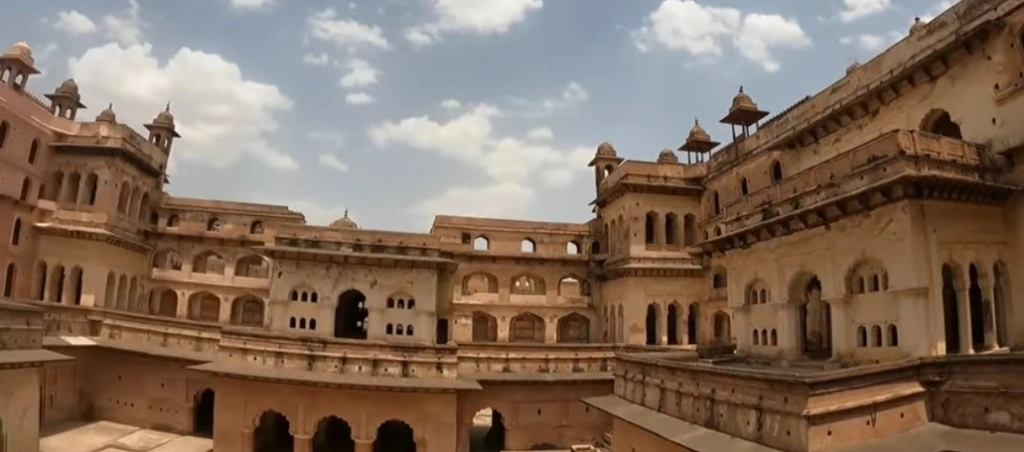
The history of Bundelkhandi kings is 1000 years old. The first king in this was Raja Hem Singh Bundela, who is also known as Pancham Singh Bundela. Orchha used to be a dense forest in the 16th century. Then Rudra Pratap Singh, son of the then king Malkhan Singh, decided to build a fort here.
Before Raja Rudra Pratap Singh, the capital of Bundelkhandi kings used to be Garhkundar, which was about 50 kilometers from Orchha. Raja Rudra Pratap Singh was very fond of hunting. One day when King Rudra Pratap Singh was roaming in the forest for hunting, he liked this place very much.
King Rudra Pratap Singh liked this place very much because of the Betwa river flowing here, abundance of prey and being surrounded by mountains. The king found this place very safe and he decided to build a fort here. Raja Rudra Pratap Singh had started the construction work of the fort here. Being surrounded by mountains and forests, direction and time could not be known at this place. That is why Shivalinga and idols of Hanuman were installed at various places in the forest, by seeing which the morning, evening and directions could be predicted.
Unfortunately, Raja Rudra Pratap Singh died while hunting while saving a cow and the construction work of the fort could not be completed.
Raja Rudra Pratap Singh made Orchha his capital. Orchha was made the capital from the 16th century to the 19th century. Raja Rudra Pratap Singh started the construction work of this fort in Orchha city from 1501 to 1531. After him, Raja Bharti Chand, son of Raja Rudra Pratap Singh, constructed the fort from 1531 to 1554, but Raja Bharti Chand died in 1554 and had no children. After Raja Bharti Chandra, his younger brother Madhukar Shah completed the construction of Orchha Fort between 1554 and 1592. During the time of Madhukar Shah’s son Raja Veer Singh (1605-1627), Jahangir Mahal and Sawan Bhado Mahal were also constructed here. It is said that the king and queen used to live in this fort till 1783 and after that they left this place. Different types of temples and palaces were built in this fort by different kings in their times.
About Orchha Fort
Orchha Fort – Main Gate
Main gate of Orchha Fort: This was a gate which could not be broken even by elephants during the time of war. , This door had iron hooks to protect it from elephant attacks. At that time, the enemies would intoxicate their elephants and prepare them for attack and these gates proved helpful in not allowing them to enter, because these iron nails used to prick them and they were not able to attack. The view inside the Orchha Fort was never visible directly from the main gate. There was a wall in front of the main entrance and there were doors along it.
Orchha Fort King’s Palace
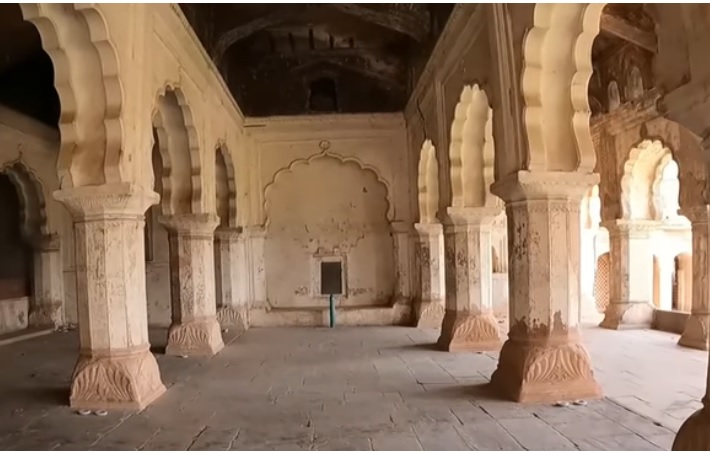
The main attraction of Orchha Fort is the King’s Palace. Inside the royal palace, there are latticed windows, balconies and paintings of gods and goddesses. The architecture of the palace is based on the ancient architectural style in which images of gods and goddesses as well as animals have been depicted. Mirror work has also been done on the palace and its walls and roofs to enhance its beauty.
Raja Mahal or the royal palace has four other attractions – Diwan-e-Aam, Diwan-e-Khas, Public Courtyard and Family Courtyard.
Diwan-e-Khas is also called a ministry. A basement was also built in it, in which due to cold air coming from all sides, it gave a feeling of coolness even in summer. Public courtyard which has iron rings with the help of which tents would have been arranged there to protect from the sun. Pictures of Rajput army are visible on their roofs. According to which Rajputi army consists of infantry, elephant army, horse army and finally camel army. The family courtyard is where the Maharaja’s palace is built and the Queen’s rooms are also built around it. The elephant figure can be said to be the main attraction of the Raja Mahal. Many secret doors have also been found here.
Kunwar Ganeshi Hall

Pictures of 10 incarnations of Lord Rama are displayed inside the chamber of the king’s chief queen Kunwar Ganeshi. The 10 incarnations of Lord Vishnu are Matsya Avatar, Kashyap Avatar, Narasimha Avatar, Van Avatar, Parashuram Avatar, Ram Avatar, Krishna Avatar, Lord Buddha and Horse/Kalki Avatar. Inside the royal palace, there is also a figure of an elephant which has been created by combining the figures of women. The walls of the Rani Mahal are also up to 2 meters wide and are interconnected so that the temperature inside the palace can be controlled.
Jahangir Palace
The influence of Mughal and Rajputani culture is visible in the architecture of Jahangir Mahal. Jahangir Mahal was built between 1605 and 1627. It is a unique example of Hindu Islamic architecture. Raja Veer Singh of Bundelkhand built this palace in honor of the Mughal emperor Jahangir. It is said that Mughal Emperor Jahangir stayed here for only one night, in his honor Veer Singh built this palace. This palace is also known as Ratri Mahal.
Jahangir Mahal is built with four pillars. Here there is an arch on the gate and carvings have been done on the stones. Figures of elephants have been carved on these stones. Scenes from the purdah system are presented in the artefacts inscribed on them. Jahangir Mahal is a two-storey building in which stairs are constructed to go up. From Jahangir Palace one could see the Betwa River and the temples of the palace. Archaeological Museum is also present in Jahangir Mahal. Along with Jahangir Mahal, Veer Singh also built Sawan Bhado Mahal.
Sheesh Mahal
Sheesh Mahal located in the Orchha Fort is a huge chamber whose ceiling is carved. Bundeljhand Raja Uddat Singh had built this Sheesh Mahal. There is a basement in Sheesh Mahal which has windows so that the place can be kept cool. Now this palace has been converted into a hotel.
Phool Bag – Flower Garden
The flower garden is a main attraction of Orchha Fort. There is a row of water fountains in the flower garden which leads directly to the palace pavilion. In which 8 pillars are also located.
Raja Ram Temple Orchha
It is said that King Madhukar Shah himself was a Krishna devotee and his wife Ganesh Kumari was a Ram devotee. When King Madhukar Shah asked Ganesh Kumari to go to Lord Krishna’s temple in Vrindavan, she politely refused and expressed her desire to go to Lord Rama’s temple. Then Madhukar Shah said that if it is so then can you bring Lord Ram here. On this, Ganesh Kumari herself went to Lord Ram’s temple in Ayodhya and continued to meditate there for 21 days, but when God did not appear, she tried to commit suicide in the Saryu river. As soon as Ganesh Kumari went inside the river, an idol of Lord Ram appeared in her lap. Then God told him, I can come with you but I have three conditions.
His first condition was that wherever I go from here and sit, I will not get up from there again. The second condition of Lord Ram was that no one else would be able to rule Orchha after him and the third and final condition was that the queen should take Lord Ram barefoot to Orchha along with the saints in a special Pushya Nakshatra.
Rani Ganesh Kumari happily accepted this condition and after this she asked Madhukar Shah to install Lord Ram in Orchha. Then Madhukar Shah built a Chaturbhuj temple along with Orchha Palace where the idol of Lord Ram was to be installed. When Queen Ganesh Kumari reached the palace with the idol, she kept the idol of Lord Ram in the Queen Palace and when preparations were made to install Lord Ram in the Chaturbhuj Palace, the idol was not taken away from there by anyone. That is why Lord Ram got established in Rani Mahal itself.
Orchha Fort – Raja Madhukar Pratap Singh
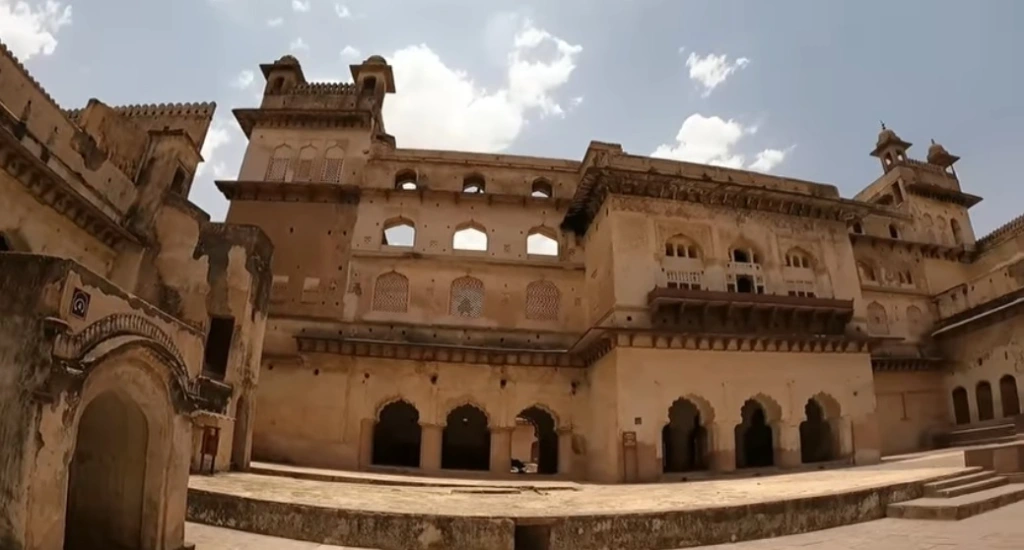
There is also a popular story about Madhukar Shah. It is said that at the time when Madhukar Shah was ruling in Orchha, Akbar was his contemporary and Akbar had set a condition for the kings to come to his court that no king would come wearing a turban and applying tilak on his forehead. But Madhukar Singh went to Akbar’s court wearing a turban and wearing a tilak on his forehead. Seeing his courage, Akbar was impressed by him and then gave him the title of Shah. Since then Madhukar Pratap Singh came to be known as Madhukar Shah. Due to this, considering his attitude, Akbar had to withdraw his order.
Orchha Fort – Light and Sound Show
Today Orchha Fort comes under the Madhya Pradesh Tourism Department and to maintain its attraction, light and sound shows are organized inside the fort. The sound and light show is organized in both Hindi and English languages, with the timings being 7:30 pm to 8:30 pm in English language and 8:45 pm to 9:45 pm in Hindi language.
OrchhaFort – nearby Places
Orchha Fort is situated at a beautiful location and there are other tourist places around it which easily attract the attention of tourists, the main ones being Chaturbhuj Temple, Lakshmi Narayan Temple, Sundar Mahal, different types of chhatris and Betwa River. Etcetera.
Best Time to Visit Orchha Fort
The weather to visit Orchha Fort is very pleasant from October to March. Monsoon time is also considered suitable to visit the fort but during summer the weather here is very hot. During those days the temperature here reaches around 45 degrees.
How to reach Orchha
Orchha can be easily reached by air, train and road. The nearest airport to Orchha is Khajuraho Airport which is located in Gwalior. The distance from Gwalior to Orchha is approximately 140 kilometers. Buses and taxis are always available from Khajuraho airport to Orchha. It is very easy to reach Orchha by train. The nearest railway station here is Jhansi Railway Station, which is only 15 to 18 kilometers away from Orchha. Orchha Fort can be easily reached by road by bus, car, taxi and this tourist place can be visited.
Time and Ticket for Orchha ka Kila
The time fixed to visit Orchha Fort is from 9:00 am to 6:00 pm. At this time you can visit the fort. A ticket of only Rs 10 can be taken to enter but for foreign tourists this ticket is available for Rs 250. Ticket prices are subject to change.
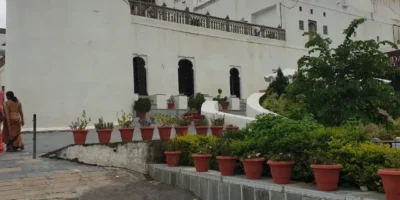
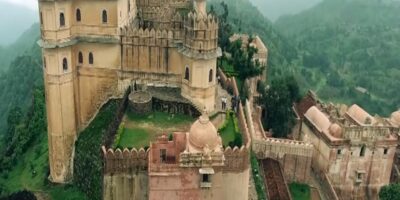
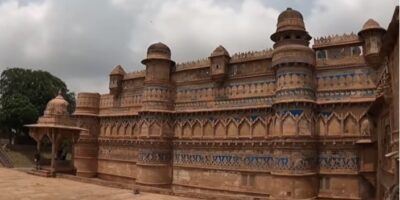
Leave a Reply